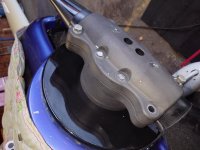bernth1961
I'm New Here
When re-pitching my Sensenic GA last weekend, 2 of the bolts seized. I had to cut the bolt heads to get the hub off. Bolts could not be moved, lugs in the prop extension rotated when I used extensive force.
From Sensenic I got (in writing) that they do not recommend anti seize.
However, by phone, I got some additional (unofficial) information, besides what I got in writing: "We love anti seize, although a mechanics will not like it. If you use it, consider lowering the torque by 5-10% due to the lubrication effect, the blades will be safely in place. We test our aluminum hubs extensively, often the bolts breaks before the hub"
Considering:
1) This must happen when we have -14 Deg C (5 F) in the hangar, making the work less attractive.
2) If this happened to one of the inner bolts, the bolt head would have to be drilled out which may or may not ruin my prop hub($$$). Difficult with my resources.
3) Lugs in my extension are stainless, prone to galling.
I'm considering using anti seize with my metal hub, but stay with dry threads whenever I'm installing the wood prop (risk of over torque).
Any thoughs?
From Sensenic I got (in writing) that they do not recommend anti seize.
However, by phone, I got some additional (unofficial) information, besides what I got in writing: "We love anti seize, although a mechanics will not like it. If you use it, consider lowering the torque by 5-10% due to the lubrication effect, the blades will be safely in place. We test our aluminum hubs extensively, often the bolts breaks before the hub"
Considering:
1) This must happen when we have -14 Deg C (5 F) in the hangar, making the work less attractive.
2) If this happened to one of the inner bolts, the bolt head would have to be drilled out which may or may not ruin my prop hub($$$). Difficult with my resources.
3) Lugs in my extension are stainless, prone to galling.
I'm considering using anti seize with my metal hub, but stay with dry threads whenever I'm installing the wood prop (risk of over torque).
Any thoughs?





